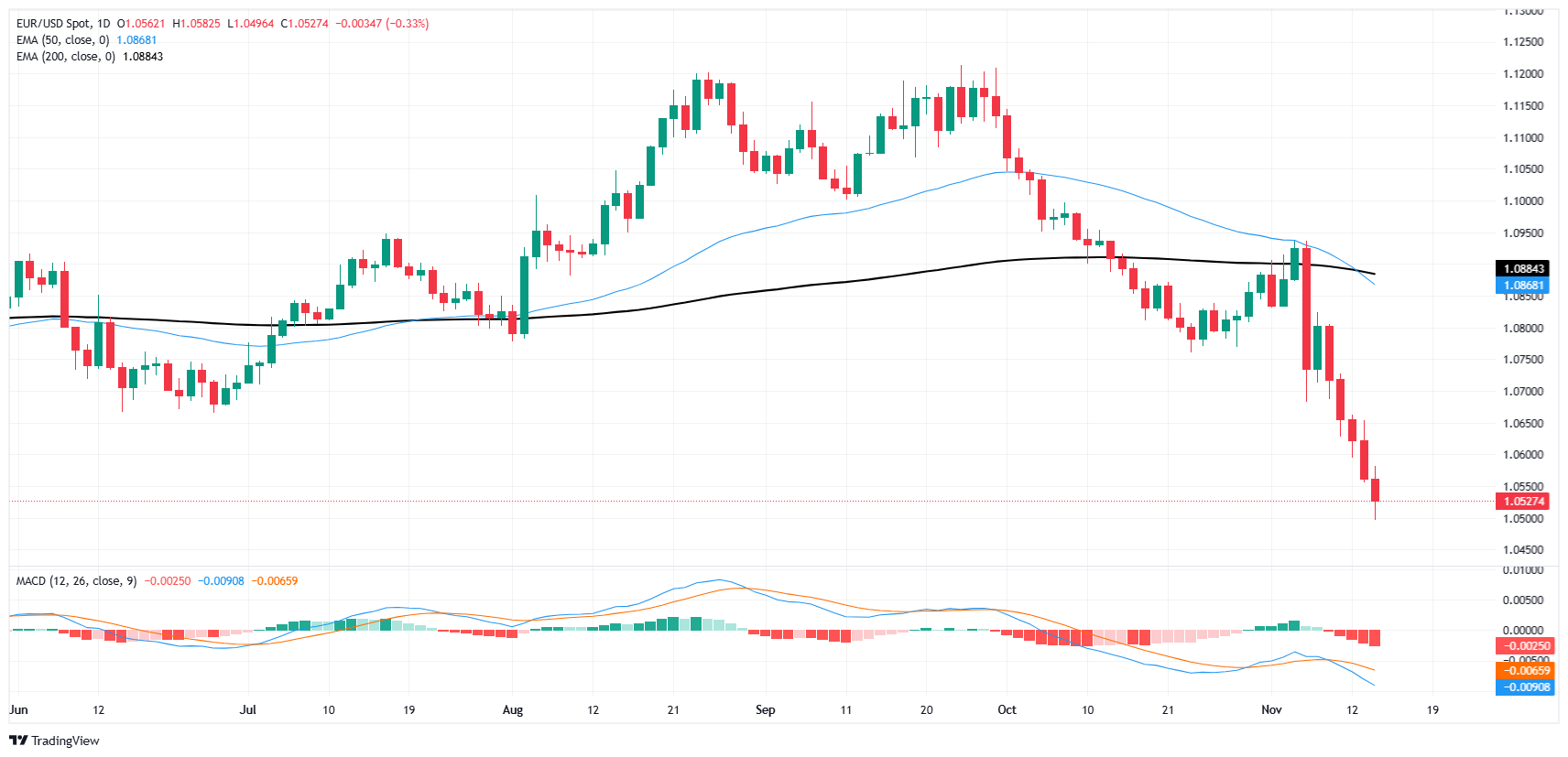EUR/USD taps 1.05 for the first time in over a year
- EUR/USD continues to decline as the Euro deflates.
- Fiber found a 57-week low as the Greenback continues to climb.
- US Retail Sales in the barrel for Friday will wrap up the economic calendar.
EUR/USD briefly tested fresh year-long lows on Thursday, piercing the 1.0500 handle for the first time in 54 weeks. A lack of meaningful EU data is doing very little to provide support for the Euro, and Fiber bids continue to tilt in favor of the safe haven US Dollar. European Gross Domestic Product (GDP) growth figures failed to spark a bid under the Euro, printing exactly at-expectations. Quarterly pan-EU GDP came in at 0.4% QoQ exactly as markets expected, with annualized GDP also matching forecasts at 0.9% YoY.
Producer Price Index (PPI) producer-level inflation figures came in roughly as expected, despite a slight upswing in annualized core PPI numbers. Headline PPI matched forecasts in October, rising 0.2% MoM compared to the previous month’s revised 0.1%. Core PPI for the year ended in October accelerated more than expected, ticking up to 3.1% compared to the expected 3.0% rising above the previous period’s 2.9%, which was also revised slightly higher from 2.8%.
The economic calendar is once again one-sided on Friday, with US Retail Sales in the barrel to wrap up the trading week. The last blast of US economic data this week will be Retail Sales for October, which are expected to ease to 0.3% from the previous month’s 0.4%.
EUR/USD price forecast
The EUR/USD daily chart is displaying sustained bearish momentum, with the pair sharply falling below the 50-day and 200-day Exponential Moving Averages (EMAs), which are positioned around 1.0867 and 1.0884, respectively. The recent "death cross," where the 50-day EMA crossed below the 200-day EMA, reinforces the downside pressure and suggests a continuation of the prevailing downtrend. EUR/USD is now trading near multi-month lows around the 1.0520 level, which could act as a psychological support in the short term. However, any recovery is likely to face strong resistance around the 1.0700 level, where the EMAs converge.
The MACD indicator further supports the bearish outlook, as the MACD line remains below the signal line in negative territory, with expanding histogram bars below the zero line. This configuration indicates a robust downward trend, with selling momentum persisting. Unless the pair manages to stage a clear breakout above the EMAs, the bias remains firmly to the downside. A break below the 1.0500 level could open the door for a deeper decline, with 1.0400 emerging as the next potential support area. Bulls would need a decisive recovery above the 1.0880 mark to negate the bearish bias.
EUR/USD daily chart
Euro FAQs
The Euro is the currency for the 19 European Union countries that belong to the Eurozone. It is the second most heavily traded currency in the world behind the US Dollar. In 2022, it accounted for 31% of all foreign exchange transactions, with an average daily turnover of over $2.2 trillion a day. EUR/USD is the most heavily traded currency pair in the world, accounting for an estimated 30% off all transactions, followed by EUR/JPY (4%), EUR/GBP (3%) and EUR/AUD (2%).
The European Central Bank (ECB) in Frankfurt, Germany, is the reserve bank for the Eurozone. The ECB sets interest rates and manages monetary policy. The ECB’s primary mandate is to maintain price stability, which means either controlling inflation or stimulating growth. Its primary tool is the raising or lowering of interest rates. Relatively high interest rates – or the expectation of higher rates – will usually benefit the Euro and vice versa. The ECB Governing Council makes monetary policy decisions at meetings held eight times a year. Decisions are made by heads of the Eurozone national banks and six permanent members, including the President of the ECB, Christine Lagarde.
Eurozone inflation data, measured by the Harmonized Index of Consumer Prices (HICP), is an important econometric for the Euro. If inflation rises more than expected, especially if above the ECB’s 2% target, it obliges the ECB to raise interest rates to bring it back under control. Relatively high interest rates compared to its counterparts will usually benefit the Euro, as it makes the region more attractive as a place for global investors to park their money.
Data releases gauge the health of the economy and can impact on the Euro. Indicators such as GDP, Manufacturing and Services PMIs, employment, and consumer sentiment surveys can all influence the direction of the single currency. A strong economy is good for the Euro. Not only does it attract more foreign investment but it may encourage the ECB to put up interest rates, which will directly strengthen the Euro. Otherwise, if economic data is weak, the Euro is likely to fall. Economic data for the four largest economies in the euro area (Germany, France, Italy and Spain) are especially significant, as they account for 75% of the Eurozone’s economy.
Another significant data release for the Euro is the Trade Balance. This indicator measures the difference between what a country earns from its exports and what it spends on imports over a given period. If a country produces highly sought after exports then its currency will gain in value purely from the extra demand created from foreign buyers seeking to purchase these goods. Therefore, a positive net Trade Balance strengthens a currency and vice versa for a negative balance.